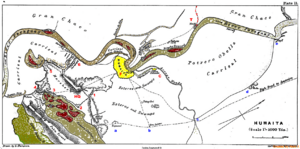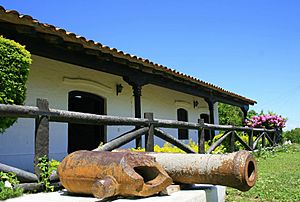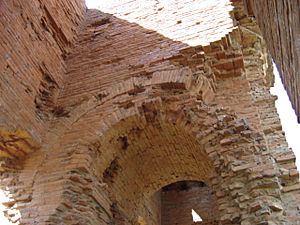Humaitá facts for kids
Quick facts for kids
Humaitá
|
|
|---|---|

Colonial houses in Humaitá
|
|
| Country | Paraguay |
| Department | Ñeembucú |
| Founder | February 1778 Pedro Melo de Portugal |
| Area | |
| • Total | 389 km2 (150 sq mi) |
| Elevation | 44 m (144 ft) |
| Population | |
| • Total | 3,214 |
| • Density | 8/km2 (20/sq mi) |
| Time zone | -4 Gmt |
| Postal code |
2840
|
Humaitá is a historic town and district in southern Paraguay. It sits right on the Paraguay River. This town was super important during the Paraguayan War (1864–1870). It was the main stronghold for Paraguay from 1866 until it was captured in August 1868. At one point, about 24,000 soldiers were stationed there! It even served as the unofficial home of the Paraguayan government for a while.
Located about 275 kilometers south of Asunción, Humaitá has a rich history and culture. You can still see parts of its old fortifications, including large earth mounds. There are also remains of a Jesuit church from the 1700s.
Contents
What Does Humaitá Mean?
The name Humaitá comes from the Guaraní language. The word "yma" means "ancient," and "itá" means "stone." So, Humaitá means "ancient stone."
Where is Humaitá Located?
The land around Humaitá is mostly flat and low. It has whitish soil and no big hills. Because it's so close to the Paraguay River, the area can flood when the river rises. This river location was very important for the city's role in history.
What is the Climate Like?
Humaitá has a subtropical climate. Temperatures can get as low as -2°C in winter. In the summer, they can reach up to 40°C.
Humaitá's Important History
The remains of the old Fortress of Humaitá are on the left side of the Paraguay River. This is about 430 kilometers south of Asunción. This fortress was extremely important during the Paraguayan War (1864–1870). It controlled who could travel up the river to the capital city, Asunción.
The defenses of Humaitá were started by Carlos Antonio López (1790–1862). Today, only the ruins of the church and possibly the town museum are left from the original fortress.
How Do People Make a Living?
The people of Humaitá mostly fish, raise cattle, and do small-scale farming.
They also create local crafts. These include vases, gloves, pictures made from burlap, and items from vegetable sponges. You can also find carpets, tapestries, tablecloths, and crocheted clothes made here.
How to Get to Humaitá
You can reach Humaitá by car from Asunción. You would take Route 1 to San Ignacio, then turn towards Pilar. Another way is to use the newer Villeta–Alberdi–Pilar Route.
You can also take a bus from Asunción to Pilar. From Pilar, you can transfer to a local bus that goes to Humaitá.
Humaitá's Historical Treasures
The city has many important historical sites. Humaitá played a bigger role than any other city in the Paraguayan War. The Paraguayan army used this city to stop the invading forces. By the end of the war, the city was badly damaged by the enemy troops.
The Cuartel de López is a museum. It used to be the barracks (living quarters) for Francisco Solano López's soldiers. It has three rooms filled with items from the battlefield. You can see bullets, cannons, stirrups, spurs, swords, and other war relics.
Visiting Humaitá
Many tourists come to visit Humaitá. Students from all over Paraguay come to see the remains from the Paraguayan War. Soldiers and regular people from Uruguay, Brazil, Argentina, and even Europe also visit.
- Ruins of Humaitá: Only a few parts of the old buildings survived the heavy bombing during the war. One of these is the San Carlos Borromeo church. Carlos Antonio López ordered its construction. It opened on January 1, 1861. At that time, it was thought to be one of the most beautiful churches in the Americas.
- Itapunta
- Curupayty
- Estero Bellaco
The Municipal Hotel is one place to stay in the city. It has an Italian-style design and was built in the late 1800s. Some historians believe that Alfredo Stroessner stayed there during the 1947 revolution.
Fishing in Humaitá
Because it's located on the Paraguay River, Humaitá is a popular spot for fishing. Fish like Mandi'i, catfish, piranha, armado, duck, dorado, surubí, and pacú are caught here. These fish provide the main income for local fishermen. Milanese surubí, a dish made with surubí fish, is a popular meal in local restaurants.
Gallery
Sister Cities
Humaitá is connected with:
 Malbrán, Argentina
Malbrán, Argentina
See also
 In Spanish: Humaitá (Paraguay) para niños
In Spanish: Humaitá (Paraguay) para niños










